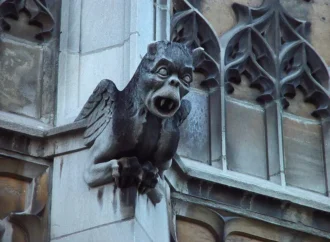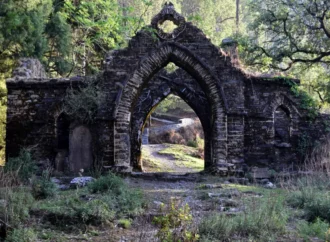Over Easter weekend, Pope Francis delivered a lovely if banal message to the world in the wake of the brutal attacks in Brussels. He called upon the world to use “weapons of love” to combat the “blind and brutal violence” employed by ISIS.
It is difficult to admonish the Pope too harshly for using the holiday as a reminder to Christendom that followers of the faith are called upon to love and forgive its enemies. The Pope is a spiritual figurehead, after all, not a military or political leader. To paraphrase Stalin, he commands exactly zero military divisions. And therein lies part of the problem.
Pope Francis bears no actual responsibility for protecting his flock from physical violence. He is allowed to spread his message of love and tolerance because of uniformed soldiers across the world who do bear that responsibility. Absent that force, Francis could easily end up like the poor Catholic priest in Yemen who reportedly was crucified by ISIS on Good Friday.
There was a time, however, when the lines between religious leader and political/military leader were not so clearly defined for the papacy. For centuries Popes were responsible protecting Christendom, and Francis might consider looking to history to see how one Pope in particular dealt with genocide and barbarism.
Pope Pius V began his papacy in 1566, the same year Suleiman the Magnificent died. He had watched as Suleiman, the longest reigning ruler of the Ottoman Empire (1299-1923), carved out an empire that stretched thousands of miles—from Algiers to Mecca, from Medina to the gates of Vienna. And Pius would watch the invasion of Famagusta and its bloody aftermath.
FAMAGUSTA
Famagusta is a city on the island of Cyprus invaded by Ottoman Turks in 1570. Venetian Christians defended the city for more than a year, inflicting heavy damage on the invaders. Sources claim there were 50,000 casualties, among them the son of the invading general, Mustafa Pasha. Finally, after a 13-month siege, the commanding officer in the city, Marco Antonio Bragadin, reached out to the attackers to see if the Christians could surrender the city under favorable terms.
The terms the defenders received were not ungenerous, notes historian T.C.F. Hopkins:
“…the surrender of Famagusta had guaranteed life and freedom to those living inside the walls: those who wished to remain and live under Ottoman rule would not be deprived of property, those who preferred to leave would not be hindered, and could take all their movable belongings with them. The Venetian soldiers could keep their personal weapons and would be carried by Turkish galleys to the Venetian garrison at Crete, along with the sick and wounded… Marcantonio Bragadin had done well for Famagusta, and for Venice, and everyone knew it—Ottomans as well as Europeans.”
On the fourth day of the truce, however, Mustafa, the general whose son had been killed, accused the Venetians of withholding treasure; he used the charge as a pretext to void the agreement. Bragadin was put into chains and his men slaughtered before his eyes. His deputy was hanged and left to rot on the city gates. Bragadin was then mutilated. His nose and ears were cut off, his beard plucked (“a particularly nasty affront in sixteenth century Islamic culture,” Hopkins notes). Mustafa himself dumped his chamber pot on Bragadin’s head.
Each humiliation was recorded by Mustafa’s personal scribe, and then Bragadin was flayed alive, stuffed, and attached to the mast of Mustafa’s ship, which carried him to the new Sultan (Suleiman the Sot, son of Suleiman the Magnificent, a drunk and reprobate) who kept him as a trophy.
Today, Famagusta’s Cathedral of St. Nicholas stands as Lala Mustafa Pasha Mosque.
THE HOLY LEAGUE
Pius V formed the Holy League in May 1571, about a year after the invasion of Cyprus but before the atrocities at Famagusta. It initially consisted of the Papal States, Spain and many of the smaller Mediterranean city-states. Notably absent from the pact was the key city-state of Venice, which stood to lose trade from an escalation of the conflict and perhaps alienate the many cities under the Ottoman banner. Also missing were the most powerful European nations—England, Portugal and France—who declined to join for various reasons.
The ally Pius really needed was Venice, and following two months of prayer the naval power finally joined the Holy League, which soon assembled a massive fleet in the Mediterranean: 200-plus galleys, nearly 30,000 soldiers, some 40,000 sailors, and 1,815 guns.
The forces clashed at the Battle of Lepanto on Oct. 7, 1571 off the western coast of Greece. Though outnumbered, the Holy League carried the day in a landslide, sinking 50 Ottoman ships, capturing 137 more, and inflicting 20,000 casualties. More than 10,000 Christians also were freed.
Later that evening, back in Rome, Pope Pius V is said to have received a vision from God. During a meeting with staff, before any word of victory could have reached him, he is said to have abruptly stood and walked to a window.
“This is not a moment for business; make haste to thank God, because our fleet this moment has won a victory over the Turks,” Pius reportedly said.
Francis and Pius V
The point in all of this is not to suggest that Pius V was a better Pope than Francis. It’s quite possible that Francis could have taught a few things to Pius in the realm of Christian love and tolerance.
The problem is that Francis seems to have a tendency of making sweeping statements on policy matters. This can be a problem when millions of religious followers treat one’s words as infallible (even if they technically don’t fall under the rubric of infallibility). His most recent comment might seem benign, but in fact Francis seems to be arguing against an escalation in the fight against ISIS and the terror and barbarism it represents.
The Pope is either failing to grasp the gravity and reach of his own words or really believe that groups like ISIS can be defeated with bursts of compassion. These are equally disconcerting scenarios.
—
Jon Miltimore is the Senior Editor of Intellectual Takeout. He is the former Senior Editor of The History Channel Magazine and a former Managing Editor at Scout Media.
















2 Comments
Stepanus Edi
December 15, 2024, 5:59 pmThe statement seems to highlight the differences in leadership styles between Pope Francis and Pope Pius V, particularly in the context of their approaches to global challenges. Pope Pius V, who led the Catholic Church during the 16th century, was known for his militant approach to external threats, including the Battle of Lepanto, which involved the military defense of Christian Europe. In contrast, Pope Francis is known for his approach that focuses on love, dialogue, and tolerance, even in the face of issues such as terrorism.
The criticism of Pope Francis in this statement seems to reflect dissatisfaction with his approach as being too soft or not strategic enough in dealing with global threats such as ISIS. However, the comparison is not entirely fair, as each pope lived in very different historical, social, and geopolitical contexts.
Pope Francis may not support an aggressive military response to groups such as ISIS, but he does emphasize justice, human dignity, and peaceful solutions. For some, this can be seen as moral strength, while for others it can seem insufficiently tough in the face of violent threats.
In contrast, Pope Pius V’s approach to military action such as the Battle of Lepanto reflected the needs of his time, when the threat to Europe was immediate and existential. Though the contexts were different, both popes faced criticism for how they handled the threats—one as too harsh, the other as too soft.
REPLYSebastian Baldrian—Lomenski@Stepanus Edi
September 13, 2025, 3:05 amThis is a drivel . The so-called Pope Francis, Cardinal Bergoglio, was a Marxist heretic. Despite his efforts at media holiness and the appearance of extraordinary love and tolerance, this man introduced an unprecedented schism into the Catholic Church, was repeatedly caught as an intolerant and grumpy old man and in his political proclamations “in favor of peace” approved Putin’s rampage in Ukraine. According to him, Putin is right because “NATO is barking at him”. He completely adopted Putin’s logic of war and passed off unconditional submission to this mass murderer as peace.
REPLY